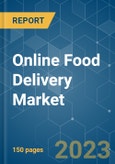Online food delivery apps have become increasingly popular worldwide, with more and more consumers opting to order their meals online. The convenience of ordering meals online has led to a significant increase in consumers using online food delivery services. These services offer ease of ordering, the availability of a wide range of cuisines, and the ability to track orders in real time. Additionally, the COVID-19 pandemic has accelerated the adoption of online food delivery services as consumers look for contactless options to order food.
In the United States, the online food delivery market has seen significant growth, with the rise of third-party delivery services such as Uber Eats, DoorDash, and Grubhub. These platforms have become increasingly popular, particularly among younger consumers, who value the convenience and variety of options available. In China, the online food delivery market has become dominated by major players, Meituan and Ele Me, which have leveraged their scale to offer competitive pricing and a wide range of services. The market in Europe has presented a more diverse landscape with a mix of local and international players.
Overall, the online food delivery industry continues to evolve rapidly, driven by changing consumer habits, technological advancements, and market dynamics. As competition intensifies and consumer expectations evolve, players must continue to innovate and adapt to stay relevant in this dynamic landscape.
Online Food Delivery Market Trends
Sustainability And Healthy Eating Habits Driving Consumer Purchase Decisions
Consumers are becoming more health-conscious and are looking for food that meets their dietary and ethical preferences. Moreover, the growing concern for the environment and animal welfare drives the trend toward healthy and sustainable food options. As a result, online food delivery platforms are responding by offering a more comprehensive range of healthy and sustainable food options, such as plant-based meals, organic produce, and locally sourced ingredients. This trend is also reflected in the rise of niche food delivery services catering to vegan, vegetarian, gluten-free, or other dietary requirements. Players increasingly work with eco-friendly suppliers and adopt sustainable packaging and delivery practices. Some companies also partner with local farmers and food producers to reduce their carbon footprint and support local communities. Therefore, as consumers become more aware of the environmental and ethical impact of their food choices, the demand for healthy and sustainable food options is likely to continue to grow, shaping the future of the online food delivery market.Asia Pacific Dominates the Market
The online food delivery market in Asia Pacific has risen in recent years, with more and more people turning to the convenience of having their meals and household essentials delivered straight to their door. The growth can be attributed to various factors, including rising disposable income, the increasing penetration of mobile devices, and changing consumer preferences. Additionally, the COVID-19 pandemic has accelerated the adoption of online food delivery services as consumers look for safe and convenient ways to order food. Another significant trend is the integration of technology and innovation. Companies use advanced technologies like artificial intelligence, machine learning, and data analytics to improve their services and offer a better user experience. This includes features like personalized recommendations, real-time tracking, and predictive delivery. Furthermore, the expansion of ghost kitchens is expected to reduce delivery times, increase efficiency in the food delivery process, and drive the overall market.Online Food Delivery Industry Overview
The Online Food Delivery Market is highly competitive, with many players vying for market share and profitability remaining challenging for many companies. Some leading players offering online food delivery services include Delivery Hero SE, Doordash, Just Eat Holding Limited, Deliveroo, and Uber Technologies Inc. The key strategies companies prefer to strengthen their market dominance include expansion, mergers and acquisitions, and partnerships to consolidate and optimize their offerings. Besides expanding their business size and reach, companies emphasize R&D in developing technologically advanced and differentiated services to gain a competitive edge.Additional Benefits:
- The market estimate (ME) sheet in Excel format
- 3 months of analyst support
This product will be delivered within 2 business days.
Table of Contents
Companies Mentioned (Partial List)
A selection of companies mentioned in this report includes, but is not limited to:
- Delivery Hero SE
- Grab Holdings Inc.
- Just Eat Holding Limited
- Uber Technologies Inc.
- Roofoods Ltd (Deliveroo)
- Yum! Brands Inc.
- Delivery.com, LLC
- Bundl Technologies Private Limited (Swiggy)
- Zomato Ltd
- DoorDash Inc.








